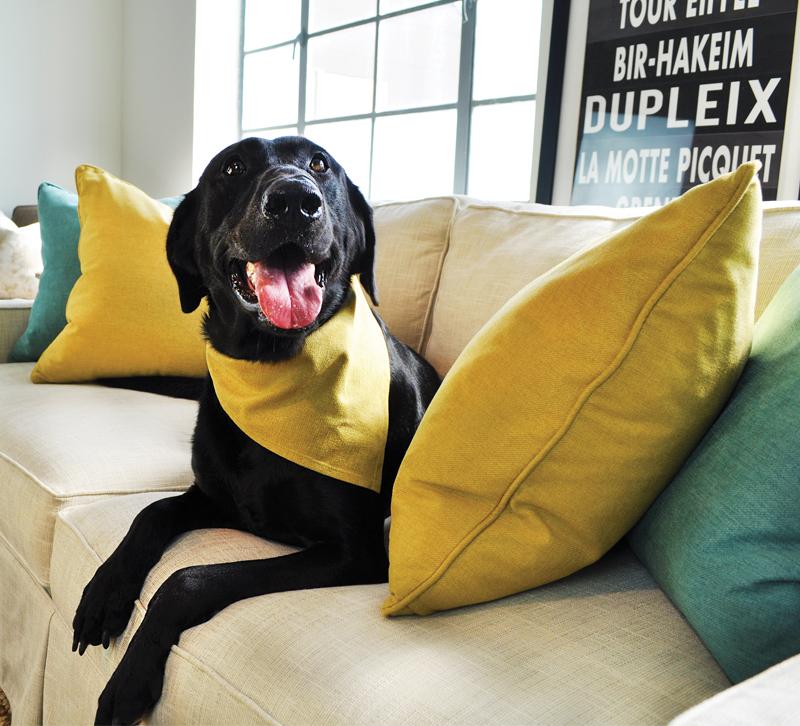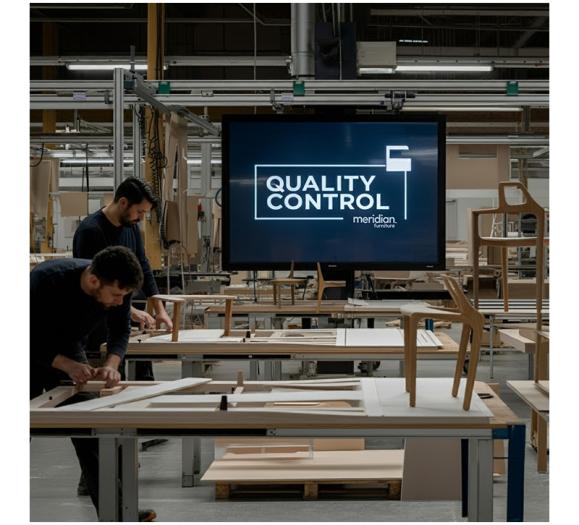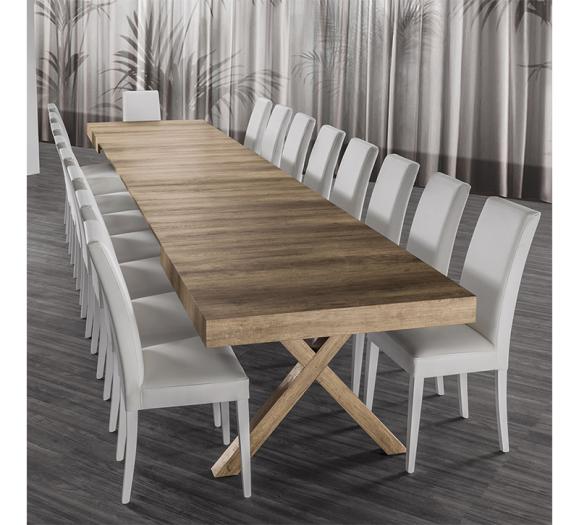Fact: There are four times more pets in the U.S. than children. According to a Washington Post article on the subject entitled, “Millennials Are Picking Pets Over People,” three-quarters of Americans in their 30s have dogs, while 51 percent have cats.” In the article, Jean Twenge, a psychology professor at San Diego State University and author of “Generation Me” chalks this demographic phenomenon up to the fact that pets “are less expensive.”
Well, maybe. Anyone who has shopped for a sofa lately at a furniture store might disagree. As one fabric exec says, “I challenge anyone with kids or pets to try to buy a sofa today without a protection plan attached. The salesperson won’t let you out of the store.” Indeed, query any floor salesperson in a typical full-line furniture store and they’ll tell you that they up-sell fabric protection plans on as many as 75 to 80 percent of their upholstered furniture sales. They will also tell you that they are incentivized to do so by their compensation structure.
As background, fabric protection plans for many years actually consisted of spraying a sofa, loveseat or chair with a fluorochemical finish like Scotchgard, usually applied in the store’s warehouse prior to delivery to the customer’s home. These days, due to environmental concerns and a host of other issues, the “wet” method has largely (though not entirely) been replaced by “dry” warranties that function like extended service contracts. Nothing is applied to the furniture, but it is protected, or covered, by a policy against mishaps such as accidental stains. Of course, the final sale price reflects the additional cost of protecting said item from your little darlings, furry or otherwise.
The New Wrinkle
No one interviewed for this story disputes that protection plans are a major profit center for furniture retailers and have been for years. That might have been the end of the story, had it not been for advances in technology that have led to the rise of an entirely new category of fabrics designed to guard against spills and other accidents, with or without a protection plan. These fabrics migrated from the outdoor awning and marine businesses, as well as apparel, an industry in which engineers have long labored to give athletes a competitive edge by building in extra levels of comfort and protection in everything from undershirts to outerwear. Rare is the weekend warrior who is not familiar with performance wear brands like CoolMax, which draw moisture (perspiration) away from the skin. Depending on the application, these performance textiles can also offer antimicrobial and anti-odor properties and even protect from the sun’s harmful rays.
It was only a matter of time before these so-called smart fabrics began dressing our furniture. And, given the current trends toward more casual and relaxed living, demand for performance fabrics is growing exponentially every year.
“The category is simply exploding,” says Tammy Buckner, Creative Director, Culp Upholstery Fabrics, which produces the LiveSmart brand featured in La-Z-Boy stores among others. (To produce LiveSmart, Culp combines a performance fiber with a performance finish to create fabrics that are moisture-repellent and stain-resistant.) “Consumers now are looking for something that is going to stand up to pets, family and everyday living.”
This is a far cry from styles of living just a generation or two previous. “I grew up in a house in New Jersey where the living room was reserved for state occasions,” observes furniture and fabric designer Joe Ruggiero with a laugh. “But that’s not how I raised my own children. They were raised to be able to enjoy living in the living room. In our home, we believe in using the dining room on a daily basis too, and we can do it because all the seats are covered in Sunbrella®.”
Here Comes the Sunbrella
Ruggiero was first introduced to Sunbrella, a division of textile titan Glen Raven, while serving as Editor-in-Chief of Home magazine years ago. He used it at his own house for a project and his wife was sold, telling him she’d never seen anything wash up so beautifully.
Hal Hunnicutt, Vice President of Marketing at Glen Raven, says “When synthetic fiber technology came along after World War II, we began investigating how some of that technology might apply to fabrics that have to spend their lives outdoors exposed to the elements. We worked with Monsanto and developed, and have been refining ever since, what we feel is the best technology for outdoor environments. And for a long time, that’s how everybody thought of Sunbrella, as a fabric for outdoor furnishings. But, what those of us here in the office that had kids and pets knew was that the product could be cleaned by anything. So we started ordering yards of it to take home and re-upholster our sofas. One day we finally said, “You know? This might actually be a business.”
As little as 15 years ago, Hunnicutt relates, with the fabric maker’s emphasis on solids and awning stripes for the outdoors (and the color blue for boat covers), there was no need for a Sunbrella design department. Today there are 20 designers worldwide, and with the recent announcement that Glen Raven Inc. has signed a letter of intent to acquire Sunbury Textile Mills, that number will soon double.
Ruggiero serves as both a designer and spokesperson for Sunbrella, encouraging designers via multiple presentations each year to embrace the line for use on interior furnishings. “People today are rethinking their space,” he says. “There are a lot of multipurpose rooms and we really want to enjoy them, even opening them up to the outdoors without a care. And honestly, I don’t understand why it’s taken so long.”
Clearly, interior designers like Ruggiero grasped the product’s potential earlier than most. Gwen DeBruyn, owner of Bayberry Cottage, is located in a resort town on Lake Michigan. She believes her decision to offer Sunbrella has actually become a key differentiator that helps her compete with larger, big-box stores where salespeople are compensated to sell fabric protection plans. “When Joe came onboard at Sunbrella it was for us an ‘a-ha’ moment. He started to give the design of the products personality,” DeBruyn says. “We always recommend Sunbrella to our clients because they’ve got kids coming in off the beach, they’ve got dogs, and they’ve got sand. People live in their homes differently here. They are laidback and they are here to play and we’ve had people come to us just because they’ve heard that we carry Sunbrella. When they walk into a small store like mine, they are walking into a store where the only goal is customer service. My salespeople don’t work on commission. They just want to make the customer happy and Sunbrella has enabled us to carve out a niche for ourselves with a product that is easy to stand behind.”
The Vision Quest
Despite the obvious increase in consumer interest, Cathy Smith, Creative Principal at TEXpertise — a company that helps new textile vendors successfully enter the U.S. fabric market via business development advice, merchandising strategy and design — points out that although “performance fabrics have gotten a lot of press in the past few seasons, and deservedly so because there are a lot of new options on the market, full-line furniture retailers have been slow to get on board. There are still furniture retailers that continue to say, ‘Don’t take away my profit center.’ There is still very vocal resistance.”
Josh Tatelman, Vice President of Merchandising at Top 100 retailer Jordan’s Furniture in Boston is a notable exception. “I shop the Market quite a bit, and I was getting tired of seeing the same thing,” he says. “In a lot of the upholstery showrooms that I was walking through — some that we do business with, some that we don’t — I started seeing Sunbrella popping up here and there. I was familiar with it because of all the outdoor furniture we sell, but at that point it had never really played a strong role in indoor furniture. It seemed like the product had come a long way, the hand had gotten a lot softer, and I thought, ‘There might be something here we can talk about.’”
In no uncertain terms, there was. Today, Sunbrella is the sponsor of Jordan’s popular IMAX theaters, and as such, every seat is upholstered in Sunbrella with an embossed Sunbrella logo, along with plenty of advertising and signage to get the message across. The theater doors open up into a 2,000- to 3,000-square-foot Sunbrella Gallery in each of the stores, where every single piece of upholstered furniture is covered in Sunbrella fabric. And no one living in the Boston television market could possibly miss Jordan’s engaging — often hilarious — pitchman Elliot Tatelman regularly educating viewers about the benefits of the product. [Note here to readers: See YouTube Jordan’s Furniture Sunbrella for samples.]
“We’re always trying to tell a story, to get people into our stores for an experience, not just for price,” Josh Tatelman says, adding that he took a very different approach in making the partnership with Sunbrella a reality. “Instead of working with a manufacturer, I contacted Sunbrella first, telling them that I wanted to create the first Sunbrella gallery in the country for interiors. It was a risk, because it was much more expensive than anything that we carried, and price points on all of our products were going to go up an average of $200 to $300 a sofa. I also wasn’t sure in the beginning if the consumer was going to understand it, and whether it would appeal to them.” Based on his gut, he reached out to every one of its upholstery partners and said, ‘If you do not offer the full assortment of Sunbrella fabrics, you are no longer going to do business with Jordan’s.”
“I told them, ‘I’m not asking you to invest in anything, because you can do everything through Trivantage’s cut yardage program, and you can price it out however you want, as long as it’s still a value.’”
Additionally, the executive reports, “We’ve always sold fabric protection extremely well; our conversion rate is very, very high, somewhere between 75 to 80 percent.” As it turns out, that number did not fall off very much with the addition of Sunbrella. The key, Tatelman says, is focusing on the one feature in Jordan’s dry protection warranty program that no fabric manufacturer covers, and that is rips, tears and burns. Bottom line: In the first year, Sunbrella accounted “for 15 to 20 percent of Jordan’s upholstery business.”
The Ball of Confusion
Three years in, Tatelman says the program is still going strong. “Performance fabrics in general have gotten a lot bigger. The challenge for us is, with as much success that we’ve had with Sunbrella, and with as much money as we have invested in the product, we now have competing performance fabrics on our floor and I’m spending a lot more time than I normally do at Showtime [the bi-annual fabric show], just trying to make sure that we’re competitive, because every manufacturer now has a performance handle.”
Of course, as the retailer relates, “Not every retailer can sell Sunbrella price points. A lot of them just don’t get it, and their salespeople don’t know how to sell it, so they’ve got to find competing products that tell a performance story at a price.”
That has opened the door in the past two years to what has fast become a crowded landscape rife with confusion about the category, both in the trade and among consumers. Indeed, the latter, industry experts suggest, now ask for Sunbrella as they might Kleenex when they want a tissue.
David Shilesky, Vice President of upholstered furniture manufacturer Rowe Furniture, saw the writing on the wall and moved quickly to re-cast Rowe’s version of the performance story. “The way we approached it was, ‘Okay, there are a lot of great textile suppliers and vendors that we deal with that supply the 1,000 fabrics in our line.’ We wanted to harness the best performance brands, but at the same time, we knew the category would evolve and it has.”
Rowe introduced its KidProof concept at the High Point Market last fall to highlight the benefits of multiple performance fabric suppliers with easy-to-understand marketing materials. An icon of a small green hand attached to swatches on Rowe’s fabric wall identifies which of the 1,000 included there are performance fabrics — making it quick and easy for consumers to choose among them. A simple tearsheet includes a grid that makes it easy for retail salespeople to quickly identify which performance factors matter most to their customer — leading some retailers to hail a piece of paper as the single best thing they saw at Market last October. In High Point this fall, Rowe is taking the concept a step further with the introduction of its own performance fabric brand, WearProof and WearProof Plus, which folds all new performance fabric vendors under one Rowe umbrella.
“Everyone’s primary responsibility is to educate the consumer,” Shilesky says. “Ultimately consumers want to make an educated choice, and it’s our responsibility to provide them with a very simple format that allows them to make an educated decision about the best fabric for their home. Already, we’ve noticed that 30 to 35 percent of all our special orders are performance fabrics, and what we’re achieving by introducing WearProof and WearProof Plus is the ability to encompass all the textile options that exist for us as a manufacturer under our own house brand, which again, will simplify the decision-making process for consumers.”
Telling a Different Story
Obviously, each fabric supplier’s performance story differs in construction and attributes. Sunbrella, for example, is 100 percent solution-dyed acrylic, which means that the fabric’s fibers are dyed in a color solution before they are woven. Others, like Culp’s LiveSmart, offer a performance finish layer on top of a performance yarn.
Then there is the unique story of Revolution, made by STI Kings Plush, which eschews the use of polyflourinated (PFC) chemicals in favor of polypropylene. A stain-resistant fabric made entirely in the U.S. using an upcycled fiber, Revolution does not, as they say in the business, “bead,” meaning that any liquid spilled on the fabric will soak through, unless mopped up immediately, unlike other performance fabrics where liquids float on top until removed. “That makes us the dark horse in the race,” says Anderson Gibbons, Sales and Social Media Strategist for the company, “but the reason performance fabrics bead is because they are covered in PFC chemicals which may not be great for you. The analogy that we use is that everybody knows fast food is bad for you, but half the people in America still eat it. We’re giving consumers a little greener choice, and we will serve those who choose to eat the salad.”
Unlike Sunbrella’s massive consumer marketing push, Revolution’s marketing is largely word of mouth via social media channels. “It might sound corny, but we think social media and Instagram are the best ways to reach consumers. It’s organic. We put the information out there and people read it.”
As evidenced, Gibbons says, by the fact that Revolution currently produces 500,000 yards of fabric per week. By publication time, that figure will bump to 750,000 yards a week as an additional 150,000-square-foot manufacturing facility comes on line. And, the company is not too concerned about more retailers waking up to the performance fabric story anytime soon either: Ninety percent of its production is sold to furniture manufacturers, and Gibbons says STI has recently unveiled a webstore — Revolution By the Yard — making cut yardage available to consumers, as well as the trade, at reasonable price points.
For now, the industry’s eyes are on High Point, both for October Market, and for the next chapter of the performance story to be written at Showtime in December. “Stay tuned,” cautions one industry insider. “At the textiles show in Shanghai late this summer, the Chinese were offering performance treatments using extruded olefin fibers for as little as 6RMB or less than one dollar a meter. I will not be surprised if some are ready to show those goods by Showtime. Frankly,” he says, “there was no way the Chinese mills that I’m familiar with were going to let this category grow under their noses, and in my opinion, they are going to end up turning this whole thing on its head in very short order.”







